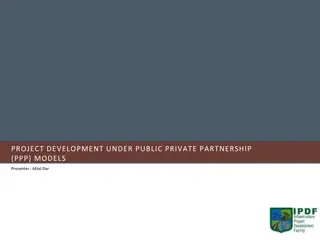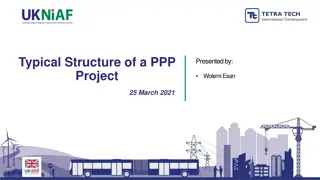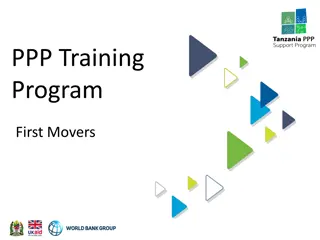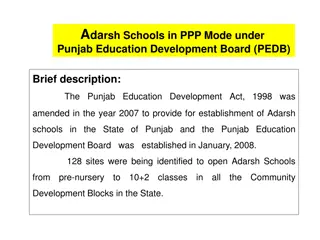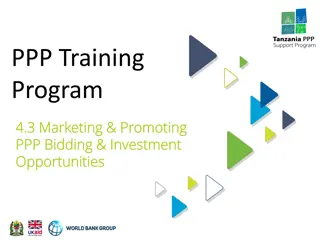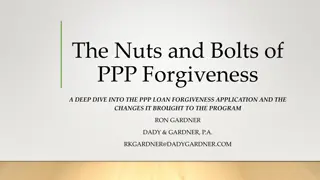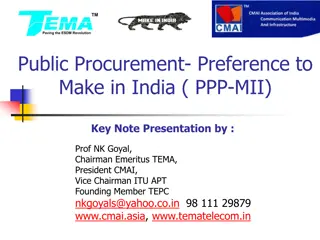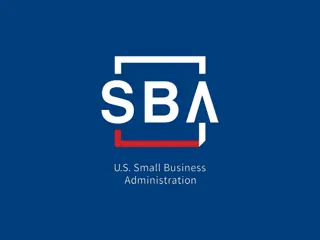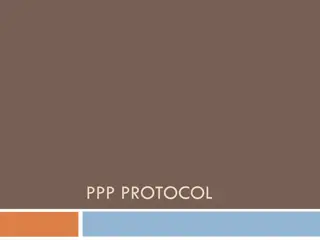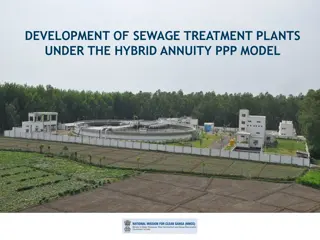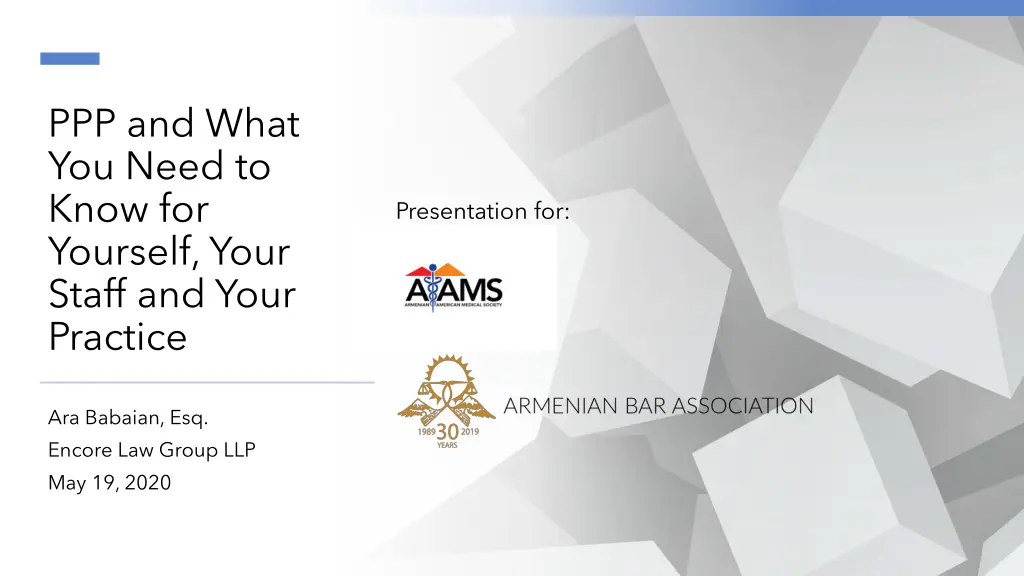
PPP Overview and Eligibility Guidelines
Understand the Paycheck Protection Program (PPP) including eligibility guidelines, loan terms, and loan forgiveness. Learn how PPP helps small businesses affected by COVID-19 with loans that can be forgiven if used for specific expenses. Find out about the application process and requirements.
Download Presentation

Please find below an Image/Link to download the presentation.
The content on the website is provided AS IS for your information and personal use only. It may not be sold, licensed, or shared on other websites without obtaining consent from the author. If you encounter any issues during the download, it is possible that the publisher has removed the file from their server.
You are allowed to download the files provided on this website for personal or commercial use, subject to the condition that they are used lawfully. All files are the property of their respective owners.
The content on the website is provided AS IS for your information and personal use only. It may not be sold, licensed, or shared on other websites without obtaining consent from the author.
E N D
Presentation Transcript
PPP and What You Need to Know for Yourself, Your Staff and Your Practice Presentation for: Ara Babaian, Esq. Encore Law Group LLP May 19, 2020
Presentation Outline What Does All This Mean? PPP Overview Eligibility Guidelines and Loan Terms Loan Forgiveness Documentation Statistics
PPP Overview Paycheck Protection Program (PPP). Offered by the U.S. Small Business Administration (SBA) in consultation with the U.S. Department of Treasury. Under the Coronavirus Aid, Relief, and Economic Security Act (CARES Act). Designed to provide a direct incentive for small businesses to keep their workers on payroll. SBA will forgive loans if all employees are kept on the payroll for 8 weeks and the money is used for payroll, rent, mortgage interest, or utilities. Prepayments of mortgage interest are NOT forgivable. Other prepayments not addressed. Prepayments of non-payroll expenses incurred before the covered period but paid during the covered period MAY be forgivable. Apply through any existing SBA lender or through any participating federally insured depository institution, federally insured credit union, and Farm Credit System institution.
Eligibility Requirements Must be impacted by COVID-19. Any business concern that meets the SBA s size standards. Any business, non-profit organization, veterans organization, or Tribal business concern: With less than 500 employees, or That meets the SBA industry size standard if more than 500 Any business with a NAICS Code that begins with 72 (Accommodations and Food Services) that has more than one physical location and employs less than 500 per location. Sole proprietors, independent contractors, and self-employed persons.
Loan Terms Loan amount based on 2.5 times average monthly payroll (cap at $10M). Loan fully forgiven if the funds are used for payroll costs, interest on mortgages, rent, and utilities. At least 75% of the forgiven amount must have been used for payroll ( incurred or paid ). Payroll includes: salary, wages, commissions, payment of vacation, sick, parental/family/medical leave, payment of retirement contributions, group health coverage premiums, and state and local taxes assessed on payroll. Loan payments deferred for six months. No collateral or personal guaranty. No fees charged by either the government or the lenders. Loan maturity of 2 years and an interest rate of 1%. No pre-payment penalty. No taxes incurred based on loan forgiveness, but the borrower must make federal employee withholdings based on payroll.
Loan Forgiveness Based on the employer maintaining or quickly rehiring (or in good faith attempting to hire) employees and maintaining salary levels. Forgiveness will be reduced if full-time headcount declines, or if salaries and wages decrease, by June 30. The loan forgiveness form and instructions include several measures to reduce compliance burdens and simplify the process for borrowers, including: Options to calculate payroll costs using an alternative payroll covered period that aligns with borrowers regular payroll cycles Flexibility to include eligible payroll and non-payroll expenses paid or incurred during the 8-week period after receiving their PPP loan Step-by-step instructions on how to perform the calculations required by the CARES Act to confirm eligibility for loan forgiveness Borrower-friendly implementation of statutory exemptions from loan forgiveness reduction based on rehiring by June 30 Addition of a new exemption from the loan forgiveness reduction for borrowers who have made a good-faith, written offer to rehire workers that was declined
Forgiveness Application The SBA just released the PPP Loan Forgiveness Application. Clarified a few critical definitions and documentation requirements. The forgiveness application is completed by the small-business borrower and is submitted to its lender (probably after the 8- week period after the loan is funded). The SBA makes the final decision regarding loan forgiveness. Three Three- -Part Calculation Method Part Calculation Method (to determine forgiveness amount): First, total of the payroll and qualifying non-payroll costs that the business has spent over the 8-week period since it received its PPP funds. Second, the forgiveness amount is reduced if you have reduced pay for employees greater than 25% (except for salaries of greater than $100,000) or if you have not brought back the same number of full-time equivalent (FTE) employees. Reduce loan forgiveness request if borrower does not bring back the same number of pre-pandemic employees. Waiver of this reduction if the business failed to bring back the same employee count during its 8-week period but later brought back the same number of employees by June 30, 2020. Reduction in headcount does not include employees who refuse a written offer to come back to work, quit or were fired for cause. Third, the forgiveness request must be comprised of at least 75% payroll costs. Other 25% can only be rent, mortgage interest debt and utilities. If the forgiveness request in step three exceeds 75%, then you will instead take the amount of your payroll costs and will divide that by 0.75, and this will give you your total forgiveness amount. Example: If payroll costs are $70,000 and non-payroll costs are $30,000, you would only be at 70% and the non-payroll costs would need to be reduced. The application calculation ($70,000 divided by 0.75) would bring the total forgiveness amount to $93,333. The balance is not forgiven.
Forgiveness Application Continued Rent includes leases of personal and real property (e.g., autos, copiers, etc.). Same thing with mortgage interest payments on real and personal property. Utilities includes internet, transportation and telephone (for which service began before February 15, 2020). Average FTE calculation: Two alternative methods to calculate FTE employees before the pandemic and during the 8-week period. Full time equivalent (FTE) employees are determined based on a 40-hour work week, with an option to treat all employees who work fewer than 40 hours in a week as one-half (1/2) of a FTE.
Certification The forgiveness application contains a page of borrower certifications. These certifications include that: The forgiveness amount requested was used for eligible costs, includes deductions arising from headcount and salary reductions, does not include more than 25% of non-payroll costs, and does not exceed maximums for owner- employees or self-employed individuals. The borrower has accurately verified payments for eligible costs sought to be forgiven (i.e., self-verification; can t only rely on professional advisors). The borrower has given the lender the required documentation verifying costs (possibly including documentation that is not currently required). The tax documents submitted to the lender are consistent with those the borrower has submitted or will submit to the IRS and local authorities. If your loan amount is under $2M, the borrower is subject to random or targeted audits. If your loan amount is over $2M, the borrower will be automatically scrutinized and so must retain additional documents to support its certification.
Timeline for Application Submit forgiveness application and supporting documentation to their lender, and the lender will have 60 days to approve or reject the forgiveness request. Talk to your banker. Focus on the details in the forgiveness application. Provide complete answers. Provide clear documentation.
Document Retention For 6 years after loan is paid or forgiven: Documents verifying cash compensation and non-cash benefits. Documents showing, at the borrower s election, the average number of FTE employees on payroll per month between February 15, 2019 and June 30, 2019; or between January 1, 2020 and February 29, 2020; or between other date ranges for seasonal employees. Documents verifying the existence of non-payroll forgivable items prior to February 15, 2020 and verifying payment of eligible non-payroll costs (including account statements, lender amortization schedules, cancelled checks, leases, and invoices). Documents (i) supporting lists of employees and compensation; (ii) regarding job offers and refusals, firings for cause, voluntary resignations, and written employee requests for reductions in work schedules; and (iii) supporting the forgiveness application s FTE Reduction Safe Harbor worksheet. Catch-all: [a]ll records relating to the borrower s PPP loan, including those submitted with its PPP loan application, documentation supporting the Borrower s certifications as to the necessity of the loan request and its eligibility for a PPP loan, documentation necessary to support the Borrower s loan forgiveness application, and documentation demonstrating the Borrower s material compliance with PPP requirements.
Documentation of Payroll Costs Must employ same pre-pandemic number of FTE employees. Determination period is either January 1 to February 29 or February 15 to June 30 (all dates in 2020). Additional reduction calculation if you bring back workers but reduce their pay from the pre-pandemic time-period by more than 25% Annual compensation restriction per employee or owner is $100,000. As a result, no employee or owner can have cash/wage compensation that is forgiven greater than the annualized 8-week amount of $15,385. But this cap does not include health insurance and retirement contributions paid by the business. Outline in PPP Schedule A Worksheet. Above/below $100,000 listed in separate places Owner s compensation on a separate line Flexibility given to businesses who have a bi-weekly payroll, such that they will be able to ensure that they can get 4 pay periods of two weeks into their 8-week covered period regardless of when they get the loan funds and the timing of their payroll. Required documentation: Bank accounts or third-party payroll service provider reports documenting the cash compensation paid to employees. Tax forms (or equivalent third-party payroll service provider reports). For tax forms: provide payroll tax forms (usually 941) and state quarterly wage and unemployment filings. Receipts, cancelled checks or account statements showing the amount of employer contributions to health insurance and retirement plans. Documentation for sole proprietors or partnerships that do not have payroll and do not file 941s: unclear.
Documentation of Rent, Mortgage Interest and Utilities These are acceptable non-payroll costs. Obligation/service must exist prior to February 15, 2020. Evidence of payments during the 8-week period. Documenting a business mortgage obligation: Provide an amortization schedule and receipt of payments as well as statements from February 2020 and during the 8-week covered period. Documenting rent or lease payments: Provide a copy of the lease agreement and copies of account statements from landlord/lessor showing the payments or cancelled checks evidencing the payments made during the 8-week period. If paying rent monthly, able to obtain two months worth of expenses during the 8-week period. Documenting utility payments: Provide invoices or statements from February 2020 and utility statements, bank account statements, or cancelled checks during 8-week period showing the payment.
What Does All This Mean? Challenges to bringing back employees: Unemployment benefits can be more generous Shelter-in-place orders: Employees are reluctant to return to work for safety reasons. Governments not allowing businesses to open. Even if the business can open, business can be slow and not need the same level of staffing. Be cautious about how you spend your PPP dollars to make sure that it doesn t just turn into additional debt on your business. This is not the EIDL/disaster loan program. Open new bank account to receive PPP funds; create new ledgers to show how funds are being used. Due Diligence: Potential acquirers, merger partners and/or venture capital or other investors will want to conduct a standard due diligence review of PPP issues. Also, they will expect representations and warranties to be given by the owner regarding PPP matters. Money is NOT fungible (in this case): If you deposited the PPP funds in one bank account, make sure you use the funds from that bank account to make the eligible payments. Unclear what happens if you use less than 75% on payroll costs. Need more SBA guidance. Apply for forgiveness ASAP after 8-week period. The SBA is always changing things and chances are things will get harder, not easier. Intercreditor considerations: Mandatory payments: Existing credit facilities may have payment sweep features. Financial covenants: Consider seeking to carve out PPP loans from indebtedness definitions for purposes of financial covenant calculations, particularly for leverage and fixed charge tests. Some lenders will accommodate these requests so long as the PPP loans remain forgivable. Others may exclude PPP proceeds for purposes of liquidity and net leverage tests. Events of default: PPP loans may create a cross-default of existing credit facilities.
Statistics As of May 16, 2020: Number of approved loans: 4,341,145 Approved dollar amount: $513,271,137,359 Average loan size: $118,000 Number of Lenders: 5,496 Approved loans by state: California: 505,798 totaling $66.5B Texas: 346,839 totaling $40.5B New York: 281,058 totaling $37.8B Florida: 325,845 totaling $30.3B
Ara Babaian, Esq. ara@encorelaw.com (213) 559-7395 LinkedIn: https://www.linkedin.com/in/arababaian/ Twitter: @arababaian Encore Law Group LLP can be found on Facebook, Instagram, at www.encorelaw.com, and at its DTLA or Santa Barbara offices.





